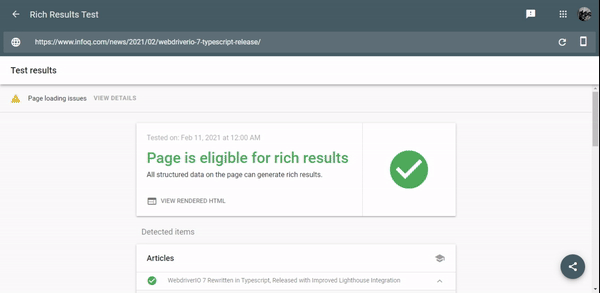Martin Splitt, search developer advocate for Google, recently explained at the Chrome Developer Summit 2020 how to use structured data to make a website eligible for rich results in Google Search. Rich results support semantic searches, stand out from ordinary search results, and may increase the click-through rate.
Google Search Central explained the value of structured data for the search engine as follows:
Google uses structured data to understand the content on the page. You can help us by providing specific information about your site, which can help your site display richer features in search results.
The Google Search Gallery lists 30 rich snippet categories with their use cases and specific user interface. The list distinguishes result categories such as articles, books, how-to, recipes, products, job postings, events, and more. Each category has a dedicated user interface that is designed to facilitate the search user’s next steps. A news article may for instance be featured in the Top stories carousel with larger-than-thumbnail images:

(Source: Google Search Gallery)
Structured data helps Google Search understand the content of a page by providing explicit clues about the meaning of content included on the page. The provided structure will include fields and information that is relevant to a given category. An example related to the recipes category is as follows:
<html>
<head>
<title>Party Coffee Cake</title>
<script type="application/ld+json">
{
"@context": "https://schema.org/",
"@type": "Recipe",
"name": "Party Coffee Cake",
"author": {
"@type": "Person",
"name": "Mary Stone"
},
"datePublished": "2018-03-10",
"description": "This coffee cake is awesome and perfect for parties.",
"prepTime": "PT20M"
}
</script>
</head>
<body>
<h2>Party coffee cake recipe</h2>
<p>
This coffee cake is awesome and perfect for parties.
</p>
</body>
</html>
The example showcases the inclusion through a script tag of structured data in the application/ld+json format (Google’s recommended format). The category (@type) is specified by schema.org, a collaborative community that creates, maintains, and promotes schemas for structured data. The example data contains the name and description of the recipe, its author, and the preparation time. This structured information can then be captured by Google Search bots (or any vendor that is equipped to extract the information) and highlighted.
Google Search is able to extract and parse the structured information as part of the indexing pipeline. Splitt explained:
As Googlebot renders JavaScript before indexing, using JavaScript to dynamically insert structured data is possible. Client-side implementations generally work. Keep in mind, though, that server-side implementations tend to be more robust.
Optimizing for rich snippets is considered by some to be advanced SEO. The recommendation to leverage structured data may come as the result of an SEO audit. Site promoters need to have a good understanding of their audience, the keywords used for search by that audience, and which of the 30 categories, if any, to leverage. SEO tools, like semrush, exist to support that process.
When structured data is added to a site, site authors must test their implementation. Google provides the rich-results website for developers to test pages ad-hoc, including temporary URLs for development purposes. The Google Search Console provides site-wide monitoring and testing for rich results eligibility. Bing, and Yandex also have testing tools available. The reader can observe here at work Google’s rich results test website on a previous InfoQ news piece:

The animated image shows that the page is understood as containing an article, and the Googlebot picks up the article description, author, and other relevant information from the structured data included on the page.
The Chrome Developer Summit is an annual conference where developers can learn about the latest tools and updates coming to the Google Chrome browser and the broader web. The 2020 edition took place online with all talks published on the summit’s YouTube channel.

